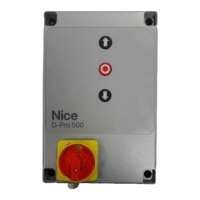ENGLISH
DPRO500
1
PRODUCT DESCRIPTION AND INTENDED USE
The DPRO500 control unit is designed to control electromechanical actuators
for automating gates, sectional doors or shutters.
CAUTION! – All uses other than the intended use described and use
in environmental conditions other than those described in this manual
should be considered improper and forbidden!
The control unit can be connected to all common safety elements. To open and
close a gate, you only need to operate the appropriate button installed on the
coverortheexternalbuttonorviaaradioreceiver.
2
INSTALLATION
2.1 - Pre-installation checks
Before proceeding with installation, check the condition of the product com-
ponents, suitability of the selected model and conditions of the intended instal-
lationenvironment:
• Check that all the materials are in good working order and suited to the
intended use.
•Check that all conditions of use fall within the “application limits” of the
product(paragraph2.2)andthevaluelimitsshowninthe“Producttechnical
characteristics”.
• Check that the installation location is compatible with the overall dimensions
of the product.
• Check that the surface chosen for installing the product is solid and can
ensure stable attachment.
•Makesurethattheinstallationareaisnotsubjecttoooding;ifnecessary,the
product may be installed, appropriately raised above ground level.
• Check that the space around the product allows safe and easy access.
• Check that all electrical cables to be used belong to the type listed in Table 1.
• Check that the automation has mechanical stops in both the opening and
closing phases.
2.2 - Product application limits
Theproductisonlytobeusedasindicatedinthefollowingtable:
Control unit power supply Type of motor*
Three-phase3x400Vac-
50/60Hz
Three-phase3x400VAC–50/60Hz–with
Nice encoder or mechanical limit switches
Single-phase1x230Vac-
50/60Hz
Single-phase1x230VAC–50/60Hz–with
Nice encoder or mechanical limit switches
(*) In respect of the corresponding application limits.
For single-phase motors, see Paragraph 3.2.
CAUTION! – The control unit described in this instruction manual
cannot be used in areas subject to the risk of explosion.
Important – Before installation, prepare the electrical cables required for the
system, by referring to “Table 1-Technicalspecicationsofelectricalcables”
.
Caution! – When laying the ducting for routing the electrical cables and for
the cable entry point into the control unit housing, be aware that due to pos-
sible deposits of water in the junction wells, the connection ducts might create
condensate in the control unit, with consequent damage to the electronic cir-
cuits.
2.3 - Installation of the control unit
Proceedasfollowswheninstallingthecontrolunit:
01. Open the control unit box: unscrew the screws as shown in Fig. 1-A /
Fig. 1-B;
02. Prepare the holes for routing the electrical cables for the accessories pro-
vidingcontroland/orsignallingfunctions.Forthispurpose,werecommend
using a special tool (e.g. hole cutter) on the marked positions at the bottom
ofthebox,alsotoensuremaintainingthelevelofIPprotection.Ifneces-
sary, you can use the lateral cable entry points, but only by using suitable
ducting connections;
03. Secure the box. Youcansecureitinthreeways:
a)directlyontothewallusingthescrewsfrominsidethebox(Fig. 2-A);
b) using the standard supports supplied (Fig. 2-B);
c) if the cable duct for routing the electrical cables is on the outside and
youneedtoxtheboxatamaximumdistanceof2cmawayfromthewall
to allow the cables to be routed behind the control unit. NDA100 consists
of4spacersandaprotectivecoverforintroducingthecablesinsidethe
controlunitbox.Toinstalltheunitusingthe(optional)accessory,referto
Fig. 2-C.
04.Atthispoint,youcanmakealltheelectricalconnections:seeChapter3.
To install the other devices used on the automated system, refer to the respec-
tive instruction manuals.
Instructions translated from Italian
Contents
IMAGES (beginning of the manual) ............................................................................... I-III
GENERALWARNINGS:SAFETY-INSTALLATION-USE ...............................................1
1 - PRODUCT DESCRIPTION AND INTENDED USE ....................................................... 3
2-INSTALLATION...........................................................................................................3
2.1-Testspriortoinstallation.................................................................................................................3
2.2-Productapplicationlimits ............................................................................................................... 3
2.3-Installationofthecontrolunit .........................................................................................................3
3-ELECTRICALCONNECTIONS ................................................................................... 5
3.1-Connectingthethree-phasepowersupplycable .......................................................................... 5
3.2-Connectingthesingle-phasepowersupplycable .......................................................................... 5
3.3-Changingthepowersupplythroughthejumper ............................................................................5
3.4-Descriptionoftheelectricalconnections:powersupply,safetyandcontroldevices,
and accessories ............................................................................................................................5
3.5-Electricalconnectionsofthecontrolunit ....................................................................................... 5
3.6-STOPSAFETYEDGEInput ..........................................................................................................5
3.7-Connectingaradioreceiver ...........................................................................................................6
3.8-Initialstartupandelectricalconnectionstest .................................................................................. 6
3.9-Totaldeletionofthecontrolunitmemory ....................................................................................... 6
3.10-RecognitionoftheconnecteddevicesandtheOpeningandClosingpositions ............................ 6
3.10.1 - Recognition of the Opening and Closing positions with mechanical limit switch ........................6
3.11-Operatingmodes ......................................................................................................................... 7
3.12-Oviewprogrammingunit ............................................................................................................. 7
4-TESTINGANDCOMMISSIONING ..............................................................................7
4.1-Testing ........................................................................................................................................... 7
5-INSTALLATIONANDELECTRICALCONNECTIONOFTWOCONTROLUNITS
FORLEAVESMOVINGINOPPOSITEDIRECTIONS .................................................. 7
6-FURTHERDETAILSANDDIAGNOSTICS ...................................................................7
6.1-Furtherdetails ............................................................................................................................... 7
6.1.1 - Signals when switching ON ........................................................................................................7
6.1.2 - Other functions ...........................................................................................................................7
6.2-Diagnostics ................................................................................................................................... 8
7 - BASIC TROUBLESHOOTING.....................................................................................9
8-PRODUCTDISPOSAL ...............................................................................................9
9-TECHNICALSPECIFICATIONS ................................................................................ 10
CEDECLARATIONOFCONFORMITY...........................................................................11
IMPORTANT!
Before performing any type of operation or
procedure, read carefully the general instructions
(page 1) and the application limits (paragraph 2.2)

